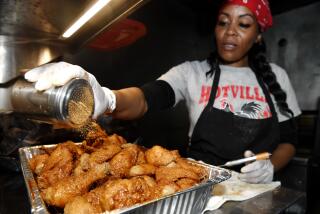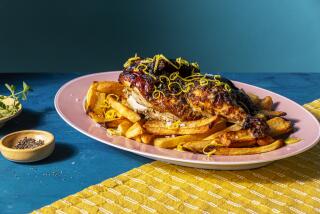Georgian Generosity
My Russian friend Anya Von Bremzen tells this joke about Georgian generosity:
The first Georgian goes to a restaurant and gives the coat check girl a $100 tip. Not to be outdone, his companion leaves a $200 tip. The third Georgian, a real mover and shaker from Tbilisi, peels off three $100 bills for the astonished girl and tells her, “Keep the coat.”
The generosity of Georgians is legendary throughout the former Soviet Union, and anyone who dines at a Georgian restaurant will quickly encounter it.
I got my first taste of Georgian generosity at two restaurants in Brooklyn, N.Y. Virtually the moment I was seated, whether at Primorski or the Pearl Cafe, a waitress would arrive with a staggering assortment of dishes: huge bowls of pickled vegetables, platters of smoked fish and caviar, a fragrant array of salads redolent with garlic, cilantro and dill. Ask for a drink and you’ll receive a full bottle of vodka.
And that was just for appetizers. An actual feast in Georgia might last four to six hours.
The Republic of Georgia is a country roughly the size of Scotland sandwiched between the Black and Caspian seas. The western part of the country has a semitropical climate that made it the fruit basket of the former Soviet Union. Plums, pomegranates and wine grapes, abundant here, are mainstays of the local cooking.
Mountainous eastern Georgia boasts one of the world’s highest concentration of centenarians, who attribute their remarkable longevity to a diet rich in yogurt, bread and fresh vegetables.
Georgians love big, robust flavors: the pungency of garlic and onion; the mouth-cleansing tartness of vinegar, pomegranate juice and sour plums. To balance the acidity, Georgians make generous use of walnuts, which are ground to make stuffings and sauces. Garlic, dill, cilantro and cinnamon are popular seasonings, as are such less familiar flavorings as fenugreek and dried marigold petals (nicknamed “Georgian saffron”).
A peek in the kitchens of Primorski and the Pearl Cafe reveals trough-like grills, where shashlyks (shish kebabs) and basturmas (tougher cuts of meat soaked in tenderizing vinegar marinades) are grilled to smoky perfection over hardwood charcoal. Grilled lamb is king elsewhere in this part of the world, but Georgians grill beef, pork, lamb, chicken and even sturgeon with equal gusto.
One of the most interesting Georgian dishes is koolheeda, a specialty of the Pearl Cafe. Named for a mythical gold mine, koolheeda features a whole boned salmon trout stuffed with a fragrant walnut-garlic-dill mixture, wrapped in grape leaves, then grilled. The grape leaves impart a delectable tartness to the fish while keeping it from drying out.
Koolheeda makes an excellent introduction to Georgian cuisine, not to mention a dramatic and festive dish for entertaining.
SALMON GRILLED IN GRAPE LEAVES
This dish is a creation of Pearl Cafe owners Nancy and Gogetidze Gelody. The original is prepared with salmon trout. I’ve called for salmon fillets, which are available in most parts of the country, but you could certainly use salmon trout. Jars of grape leaves preserved in brine are available at Middle Eastern markets and many supermarkets.
20 to 24 grape leaves
1 1/2 pounds boneless, skinless salmon fillets
Salt
Freshly ground black pepper
1 cup walnuts
2 garlic cloves, chopped
2 tablespoons chopped fresh dill or 1 tablespoon dried
2 tablespoons chopped fresh cilantro or parsley
1 tablespoon fresh lemon juice or to taste
8 paper-thin slices lemon
Thoroughly rinse grape leaves under cold water. Soak leaves in bowl in cold water to cover 20 minutes, changing water once or twice. Drain grape leaves and blot dry on paper towels.
Cut salmon fillets on the diagonal into 4 broad thin pieces. Cut deep pocket in side of each piece. Season fish with salt and pepper to taste.
Grind walnuts, garlic, dill and cilantro to coarse paste in food processor. Grind in lemon juice and salt and pepper to taste. Mixture should be very flavorful. Spoon stuffing into salmon pockets.
Arrange enough grape leaves on work surface to form 4 rectangles 2 inches larger than pieces of fish (grape leaves should overlap slightly). Place 1 fish piece on top of each. Arrange thin layer of lemon slices on top of salmon. Cover fish with remaining grape leaves, tucking in ends. (Fish can be prepared several hours ahead to this stage and stored in the refrigerator.
Just before serving, preheat grill or broiler to medium-high. Place fish inside grill basket if you have one or cook on the grill using long wide spatula for turning fish. Grill fish until grape leaves are nicely browned and fish is cooked, 3 to 4 minutes per side. To test for doneness, insert slender metal skewer into thickest part of fish. If it comes out very hot to the touch, fish is cooked.
Transfer fish to plates or serving platter. Garnish with lemon slices and serve at once. To eat, have guests unwrap grape leaves, although you can certainly eat them if you want to.
Makes 4 servings.
More to Read
Sign up for The Wild
We’ll help you find the best places to hike, bike and run, as well as the perfect silent spots for meditation and yoga.
You may occasionally receive promotional content from the Los Angeles Times.






